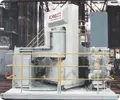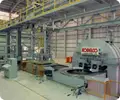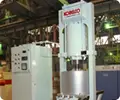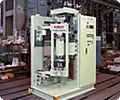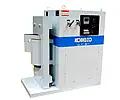Cold Isostatic Press (CIP) Equipment
What is Cold Isostatic Pressing (CIP)?
CIP, Cold Isostatic Pressing, is one of material processing methods.
It makes use of the principle "A change in the pressure of an enclosed incompressible fluid is conveyed undiminished to every part of the fluid and to the surface of its container." proposed by the French scientist Blaise Pascal. Powder materials are sealed in a forming mold with low deformation resistance like a rubber bag to apply liquid pressure. Then, the molded body is compressed uniformly over its entire surface by transmitting the liquid pressure.
Metal mold pressing is very similar to CIP. In this pressing method, as shown in the figure below, powder materials are filled into a space enclosed by the metal mold and the lower punch. Then, they are compressed by narrowing the distance between the upper and lower punches.
Metal mold pressing equipment for industrial use has a series of automated processes from powder filling to removal of a molded body. Single-acting pressing shown in the right figure compresses powder into a shape with the lower punch fixed. The lower part of the molded body will have lower density than its upper part due to the frictions between the powder and the metal mold or the punch, and among powder particles.
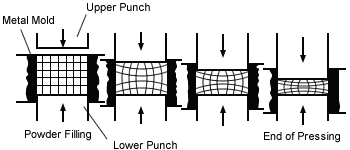
Difference between CIP and Metal Mold Pressing
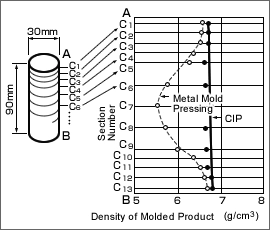
Reference: Textbook for the 1st Technical Lecture on the Latest Powder Metallurgy by Nobuyasu Kawai (1983)
In principle, they have different pressurization processes. CIP applies isostatic pressure to materials using liquid pressure, while metal mold pressing applies only uniaxial pressure. Therefore, CIP can produce a product with a uniform density and homogeneity due to no frictions with a metal mold. The right figure compares the density distribution of two products molded by CIP and metal mold pressing respectively.
Types of CIP Processing
The CIP molding methods are classified into two types: the wet bag process and the dry bag process, according to the relationship between a forming mold for filling powder and a pressure medium for transmitting pressure.
Wet Bag Process
In the wet bag process, as shown in the figure below, powder is filled in a forming mold and sealed airtight outside the high-pressure vessel before direct immersion into a pressure medium. Then, isostatic pressure is applied to the outer surfaces of the mold to compress the powder into a shape. This method is suitable for various kinds of small-quality production for complicated-shape or large-scale products and trial production research.
There are two structural types: the external pressurization type shown in the left figure below, which pressurize the pressure medium into the pressure vessel from outside, and the piston direct pressurization type shown in the right figure below, which directly pressurizes the pressure medium sealed inside the high-pressure vessel with a piston installed instead of the top closure.
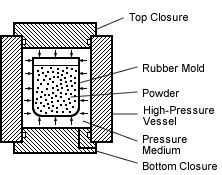
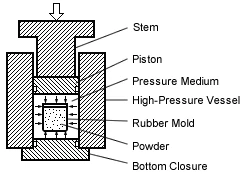
Dry Bag Process
Dry Bag process is a method to mold powder filled in a forming rubber mold, as shown in the figure below, by transmitting pressure through a pressing rubber mold in the high-pressure vessel. This method is suitable for mass production of simple and limited variety of products with its labor-saving automatic operation.
The Dry Bag process is classified into two systems: the circumferential + axial pressurization system (Left) and the circumferential pressurization system (Right) as shown in the figures below respectively.
The circumferential + axial pressurization system applies pressure from the outer surfaces of the mold and the top surface of the cap-shaped pressing rubber mold as shown in the left figure below.
The circumferential pressurization system applies pressure only from the outer surfaces of the forming rubber mold through a cylindrical pressing rubber mold as shown in the right figure below. However, due to the fluid-like property of the powder, the pressure applied to the green compact is almost equal to isostatic pressure.
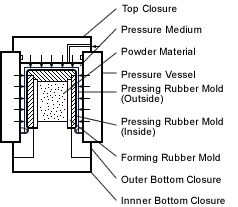
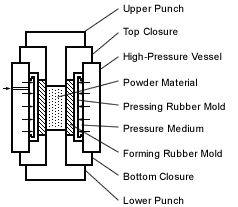
Contact Us
You can reach us by clicking the inquiry button.
